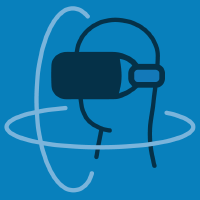Topic Menu
► Topic MenuTopic Editors



Simulations and Applications of Augmented and Virtual Reality, 2nd Edition
Topic Information
Dear Colleagues,
The impact of Virtual Reality (VR), Augmented Reality (AR) and Mixed Reality (MR) technologies is redefining the digital landscape. These technologies have been widely adopted within various domains, such as education, medicine, engineering, architecture, entertainment, art and culture. The ever-increasing adoption and accessibility of VR, AR and MR technologies have fueled a growing demand for advanced applications, paving the way for cutting-edge research opportunities.
The Topic Editors encourage the submission of original and mature research studies backed by data and data analytics that discuss the advances of VR, AR, MR and associated technologies.
This Topic is an opportunity for the scientific community to present their latest research contributions in the field of Extended Reality (XR).
Topics of interest include but are not limited to:
- VR/AR/MR applications;
- VR/AR/MR collaboration;
- Artificial intelligence/machine learning for VR/AR/MR;
- Natural multimodal interaction for VR/AR/MR;
- Content creation and management for VR/AR/MR;
- Human–computer interactions for VR/AR/MR;
- Perception/presence for VR/AR/MR;
- Education, gamification and entertainment in VR/AR/MR;
- Immersive exergames for health and wellbeing in VR/AR/MR;
- Production planning and digital manufacturing in VR/AR/MR;
- Cultural heritage and art in VR/AR/MR.
Dr. Radu Comes
Prof. Dr. Dorin-Mircea Popovici
Prof. Dr. Calin Gheorghe Dan Neamtu
Prof. Dr. Jing-Jing Fang
Topic Editors
Keywords
- virtual reality
- augmented reality
- mixed reality
- multimodal interaction
- immersive
- extended reality
- human–computer interactions
Participating Journals
| Journal Name | Impact Factor | CiteScore | Launched Year | First Decision (median) | APC |
|---|---|---|---|---|---|

Applied Sciences
|
2.5 | 5.5 | 2011 | 19.8 Days | CHF 2400 |

Computers
|
4.2 | 7.5 | 2012 | 16.3 Days | CHF 1800 |

Electronics
|
2.6 | 6.1 | 2012 | 16.8 Days | CHF 2400 |

Sensors
|
3.5 | 8.2 | 2001 | 19.7 Days | CHF 2600 |

Virtual Worlds
|
- | - | 2022 | 19.2 Days | CHF 1000 |

ISPRS International Journal of Geo-Information
|
2.8 | 7.2 | 2012 | 34.2 Days | CHF 1900 |

Preprints.org is a multidisciplinary platform offering a preprint service designed to facilitate the early sharing of your research. It supports and empowers your research journey from the very beginning.
MDPI Topics is collaborating with Preprints.org and has established a direct connection between MDPI journals and the platform. Authors are encouraged to take advantage of this opportunity by posting their preprints at Preprints.org prior to publication:
- Share your research immediately: disseminate your ideas prior to publication and establish priority for your work.
- Safeguard your intellectual contribution: Protect your ideas with a time-stamped preprint that serves as proof of your research timeline.
- Boost visibility and impact: Increase the reach and influence of your research by making it accessible to a global audience.
- Gain early feedback: Receive valuable input and insights from peers before submitting to a journal.
- Ensure broad indexing: Web of Science (Preprint Citation Index), Google Scholar, Crossref, SHARE, PrePubMed, Scilit and Europe PMC.


